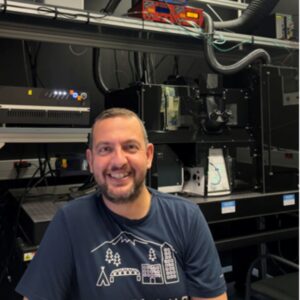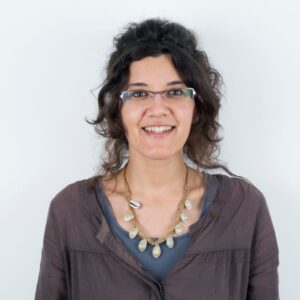Meet the poster prizes winners of ELMI 2025
In June, the 25th European Light Microscopy Initiative (ELMI) meeting made its much-anticipated return to EMBL Heidelberg for the first time since 2010. Established in 2001, ELMI has grown into a key platform for scientists, core facility staff, and industry representatives to exchange ideas, showcase technologies, and foster collaborations that advance the field of light microscopy. The 2025 edition brought together participants from across Europe and beyond, offering a packed programme of company workshops, talks from international speakers, a vibrant exhibition, and interactive community sessions.
As part of the programme, two poster sessions provided an opportunity for participants to present their latest research, innovations, and applications in light microscopy. With posters on display throughout the event, attendees voted for their favourites. We are delighted to highlight three outstanding poster prize winners: Nikolaos, Montserrat, and Krijn!
Dry Immersion Microscopy to foster multiscale long-term live imaging
Presenter: Nikolaos Giakoumakis
Authors: Nikolaos Giakoumakis, Chong Zhang, Lidia Bardia, Francesco Pampaloni, Julien Colombelli

Abstract:
Immersion objective lenses in microscopy have a primary goal: increase the collection efficiency, or NA, of the optical system, hence its optical resolution, by coupling objective lens and sample carrier through a wet layer of immersion medium, e.g. water. This wet layer is state-of-the-art in high-resolution optical microscopy, but it comes with known practical drawbacks that the community has learnt to deal with: need to refill medium when it evaporates, need to clean the lenses, immersion overflow during the experiments, increased thermal drift, etc… However, other severe limitations affect the versatility and performance of microscopy applications, in particular live imaging, and are harder to circumvent: large working distance lenses pose gravity issues to withhold millimetres of immersion medium e.g. in inverted microscopy; automatically swapping lenses of different immersion (e.g. water to air and backwards) for multiscale imaging can suffer immersion residues on the sample carrier; long term imaging requires constant refilling with sophisticated hardware and software integration; scanning large areas (e.g. multiwell) with immersion can become very challenging.
We developed an approach [1] that alleviates some of those challenges and expands the versatility of multiscale microscopy. By confining immersion medium into an optical compartment with the use of transparent thin films, we can retain the immersion layer between lens and sample carrier without wet contact, hence introducing “dry immersion” microscopy. In particular, the device can behave as a passive component and eliminate the need to refill or remove immersion medium during experiments, and opens the possibility of using a wide range of lenses in automated microscopy. We present several implementations of the device applicable to live imaging under inverted microscopes (spinning disk, confocal, multiphoton, OPM) together with DIY recipes to fabricate it with easily accessible consumables and labware, e.g. off-the-shelf films, silicon glue, 3D printer. We show the concept, basic principles, optical performance and advantages of the dry immersion for long term live, multi-immersion and high-content fluorescence imaging.
References:
[1] F. Pampaloni; J. Colombelli. Optical Pad and system employing the same. Patent WO 2021/250013 A1
Due to the confidentiality of the unpublished data, we cannot share the poster
Deep inside a gorgonian coral
Presenter: Montserrat Coll Lladó
Authors: Montserrat Coll Lladó, Jim Swoger, Teresa Madurell

Abstract:
We present a 3D imaging approach for the gorgonian coral Leptogorgia sarmentosa, a sessile colonial cnidarian that poses significant challenges due to its structure: 1) soft polyps and 2) pigmented, spiny skeletal elements (sclerites) alongside a mineralized internal axis. Although most sclerites—calcareous structures essential for support, protection, flexibility and species identification—were lost during the initial clearing steps, we found that sample pretreatment had to balance preserving polyp contrast while mitigating the intense autofluorescence of the axial skeleton.
By incorporating a pretreatment to remove calcium carbonate we significantly improved light penetration and visualization of the organism’s inner architecture, reaching the central axis. This revealed the hollow central core subdivided into chambers, forming a cord along the axis, which was previously obscured by autofluorescence. After clearing, a collagen staining protocol (Timin & Milinkovitch) allowed us to recover the “negative” imprint of the lost sclerites, effectively capturing their shape and distribution within the coenenchyme (colonial tissue).
Overall, our method enables high-resolution 3D imaging of a complex organism from its outermost polyps to its internal axis. The approach can be extended to other members of the same taxonomic group, expanding our toolkit for studying similarly challenging marine invertebrates in three dimensions.
Reference:
Grigorii Timin & Michel Milinkovitch. High-resolution confocal and light-sheet imaging of collagen 3D network architecture in very large samples. iScience 26, 2023.
DOI: Coll Lladó, M., Swoger, J., & Madurell, T. (2025). Deep inside a gorgonian coral. 25th international meeting of the European Light Microscopy Initiative (ELMI), Heidelberg. Zenodo. https://doi.org/10.5281/zenodo.15797442
Human-on-of-the-loop segmentation optimization using 3D visualization and interaction
Presenter: Krijn van der Steen
Authors: Krijn van der Steen, Matthew Smith, Bram Bosch, Jeffrey Beekman, Sam van Beuningen

Abstract:
The rapid rise of the application of Artificial Intelligence (AI) in segmentation of microscopy
data has quantifiable advantages in throughput of data, reproducibility and availability. With minimal biological or computational knowledge, high-end microscopy segmentations can be
continuously generated.
However, underrepresented data in the training set—such as different cell types or developmental stages—may be misclassified or entirely missed. This limits the models’ adaptability and reduces user trust in the generated segmentations. Diagnosing segmentation errors is difficult due to AI’s abstract nature, with millions—or billions—of parameters contributing to a single output. Varying user expertise and dataset differences present opportunities to optimize segmentation quality, especially for outliers. Key to this is identifying faulty segmentation areas. This is complicated by the growing prevalence of 3D imaging in microscopy. The complexity of 3D structures cannot be fully fathomed by the human mind from multiple 2D images in sequence, losing out on spatial relationships between images. Intuitively restructuring data into 3D modality would solve this comprehension gap.
Therefore, we propose a system with human-on -the-loop (HOTL) validation that facilitates error-validation and increases comprehension of 3D segmentation structure by converting 2D segmentations into 3D objects and making them available in virtual space. This HOTL approach reduces throughput strain and enables intuitive interaction and visualization of segmentations that are too complex for the human mind to process directly. We propose an interactive extension to the napari-blender plugin, using the Meta Quest 3 VR headset for intuitive data interaction—grabbing, rotating, and scaling 3D segmentations. Furthermore, objects can be dissected in parts, such as separate nuclei in an organoid, compared against other segmentations and their latter timeframes, facilitating quality comparison and the evolution of data over time. These different modalities of inspecting data in an intuitive and elaborate way helps the user to find shortcomings of the models performance, and retrain the model with a larger
emphasis on the markers that were falsely segmented.
The EMBL Conference ’25th international meeting of the European Light Microscopy Initiative‘ took place from 3 – 6 June 2025 at EMBL Heidelberg Advanced Training Centre and Virtual